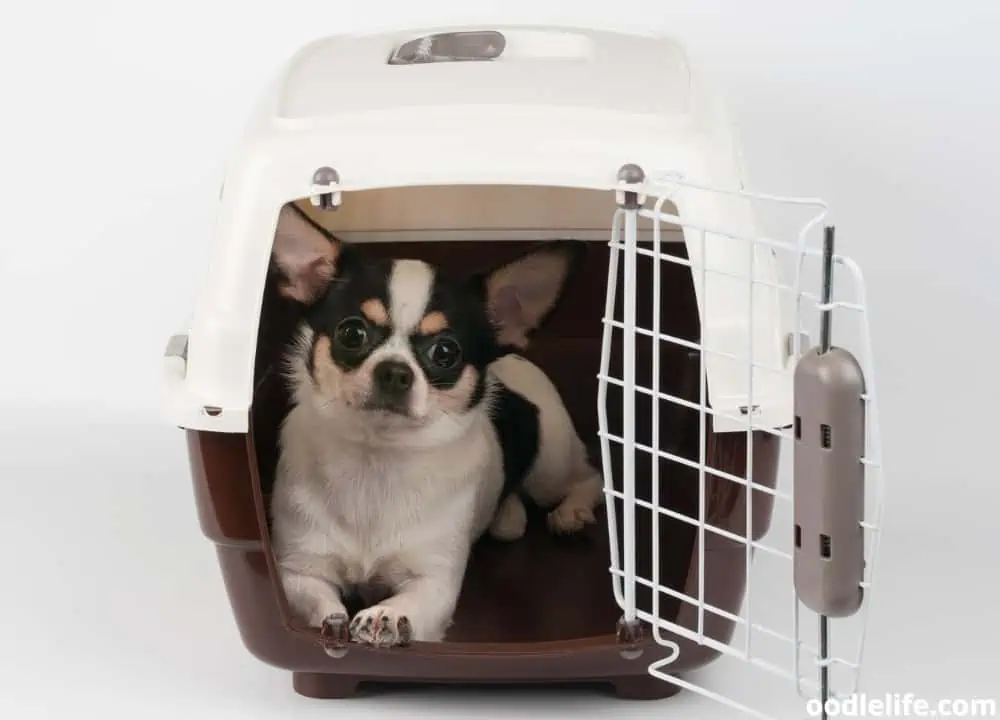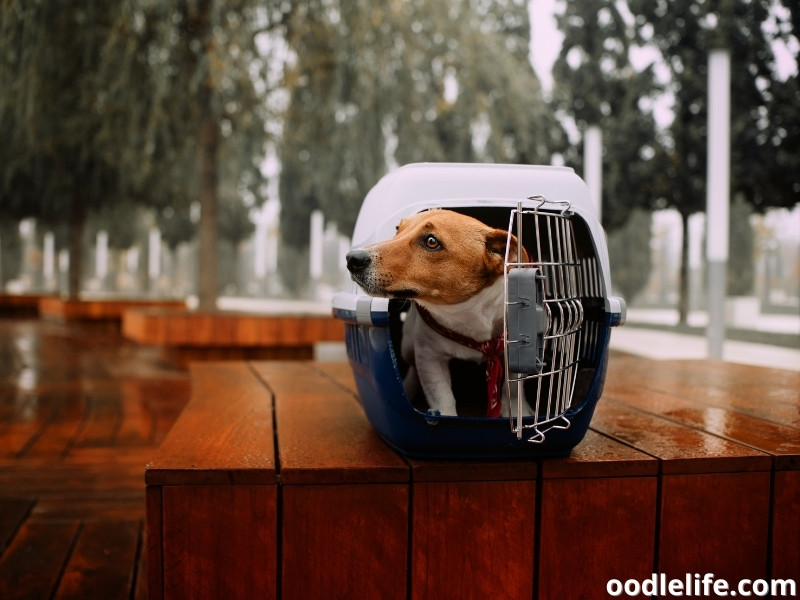When Can I Stop Crating My Dog?
Nothing divides the dog-owning community quite as much as the crate. They’re inconspicuous enough and aren’t designed to hurt dogs like some more controversial pieces of equipment and yet often find themselves lumped into the same category. This usually often comes with improper use of the crate where your dog finds itself confined against its will and it can therefore become detrimental to their health and wellbeing.
We see a metal cage and immediately assume that our beloved dogs will feel trapped and confined in them because that’s how we would feel. Bigger isn’t always better in the dog world. It’s very natural for dogs to enjoy a small space.

I once upgraded my dog’s basket thinking he would rather have the space to fully stretch out. I bought him a bed that could easily fit three of him in and assumed he would feel like a king and love it. He was restless and squeezed himself into smaller spaces because he found them to be much more comfortable.
Crates are great pieces of equipment if used right, especially in the early stages of your dog’s life. They can always be weaned away after puppy training or when your dog can be trusted home alone without causing major destruction.
Benefits of Crate Training Your Dog
Crate training might not be for everyone but there are certain benefits to teaching your dog to settle and sleep in a crate. Many dogs naturally seek out tight spaces to sleep and feel safe, even more so if they have an anxious disposition. Even the most confident of dogs may like to snuggled up against something with solid sides so they don’t feel too exposed.

As pack animals, many dogs who live in multi-dog households will choose to cuddle up together to help them feel safe.
Crates can help to indicate to your dog when it’s time to settle down. If your dog is used to resting in a crate and you put them away for some time, prior learning if the crate is introduced properly should have them napping within a few minutes! If you have guests over with young children or if they just aren’t used to dogs, crates are a really helpful way of managing your dog.
If you have a dog that gets over-excited around guests, a crate can be used to skip over that excitement by helping them to relax before coming out and saying hello to everyone.
You can set a routine with the help of a crate and even if you never plan to use a crate to shut your dog away at home, there are some situations where your dog may have to be confined and have a good association with a smaller space will be helpful. If you ever have to travel long distances or fly with your pooch they often need to be in a crate for a lengthy period. If your dog has to stay overnight at the vet’s, their kennels are often a similar size to a crate.
Preparing your dog for these situations can save them from getting stressed. Many dogs experience injuries throughout their lives or have to have medical procedures that mean they need to be rested. If your dog can relax in a crate beforehand it makes any unplanned situations like these a little easier.
Crate Training and Puppies
Training your dog to be happy in a crate will often start when they’re puppies and it can be super helpful for managing your new addition. You bring a puppy home at 8 weeks old with no toilet training, no idea how to be away from you, or even behave in a house. At this age they might be a little angel but as they grow and teeth, you’re going to wish you had a safe place for them so you can have some peace and not worry about your chair legs being gnawed on or your cushions being de-stuffed!

Puppies are hard work and crates are a godsend when you can’t yet trust them.
A puppy only learns how to behave in environments through learning. They’re not born with the ability to understand where they do and don’t toilet or what they can and can’t chew. Dogs will generally want to keep their bed areas nice and clean so it helps to have a designated spot as they slowly learn how to hold their pees overnight.
Puppies will want to be close to you as well. It’s not uncommon for puppies to cry and become stressed when they first go into their new homes. They come for a situation where they can sleep with their mother, snuggled up with their siblings and suddenly they’re alone in a strange place.
They tend to cling to you and if you’ve ever tried to shut your new puppy away in another room while you sleep, you’ve probably experienced the heartbreaking noises that follow. Crates are great for getting a full night’s sleep while allowing your puppy to be in the same room as you.
How To Introduce a Crate?
A crate should be introduced gradually, in other words, you don’t just pop your dog in, close the door and call them to crate trained. If you go down that route you’ll likely find yourself with a very distraught dog who doesn’t understand why they’re being shut away. A crate should be a safe place.

Puppies tend to take to them easier so if you get them sleeping in a crate from the first night, half the training work is done for you. For an adult dog, it’s more important to create a positive association if they’ve never used a crate before. Let them venture inside and discover how comfy the bed in there is and find nice high-value treats.
Once they’re comfortable inside you can start closing the door for a few seconds at a time. If done slowly they should never panic and try to get out, if they do, you need to spend more time making it a nice place.
From a few treats to a longer-lasting chew, things like Kongs are great for building duration until they can finish their treat, have a nice nap and come out if they wish. If every time your dog is crated is a positive experience, when you may need to create them later down the line they’ll find it comforting and relaxing instead of stressful.
While it’s fine to put your dog in their crate to keep them out of trouble, it should never be used as a punishment. If you shut your dog away every time they do something undesirable you will quickly poison how positive their crate is meant to be and they won’t want to rest in there anymore.
When Can You Stop Crating Your Dog?
If you’ve chosen to crate train your puppy then you can stop using the crate as soon as what you were training them to do is part of their normal behavior. If they are no longer a risk to furniture or knocking guests over or peeing in the house then you may not need to have somewhere to shut them away. If you don’t want them to have free roam of the house when you’re out but can trust them in a single room then you can gradually upgrade their access without the need for a smaller area anymore.

Even after my dogs can be trusted, I like to leave them the option of crate sleeping. They might be able to roam the entire house but after sleeping in a crate all their puppy and adolescent life, some dogs just don’t want to be crate-free. Some crates have removable doors so you can still allow them their nice safe space without needing to shut them away.
You may even have to provide extra beds so you can gradually phase out the crate if you no longer need to use it.
You can stop using the crate whenever you and your dog are comfortable without the need for it.
Should I Keep Using My Dog’s Crate?
There are some situations where a crate might be useful long-term for your dog. If they’re anxious about strangers or have separation anxiety, crates can be useful tools to use throughout their life. I had a dog for 12 years who ate every single meal in a crate because he showed quite severe resource guarding around his food bowl from a young age from people and other dogs.

By the time he was older he no longer had this issue but to avoid any conflict he continued to eat his meals in the safety of his crate where he knew nobody would bother him or remove his food before he was ready.
While crates are often sold as temporary pieces of equipment, they don’t have to be.
Conclusion
Crates are invaluable pieces of kit to have if you have a puppy or a dog with any additional behavioral needs. Sometimes, dogs just like them and want to be in smaller spaces. As long as they’re introduced and used properly then there’s never a rush to remove them.
Both you and your dog need to be comfortable without having a confined space so it’s about learning how to exist around each other without that safety net.
Working in rescue, I have trained one or two dogs who have such previous negative associations with crates that we chose to stop crate training before they were even fully comfortable to look for alternatives.
Crate training should only ever be positive and you can stop using the space as soon as you’re confident in your dog’s ability to settle without that boundary.